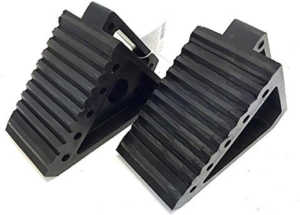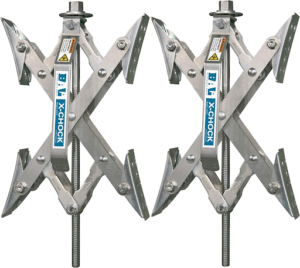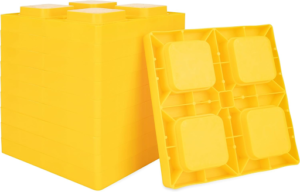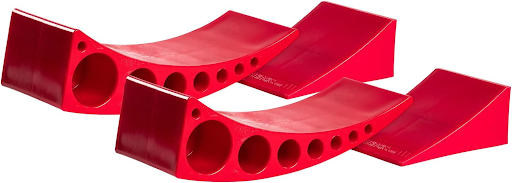
Chocks and Leveling Blocks
If you spend your money on anything, spend it on good chocks and blocks (and get ready to read those words a lot in this post)! Your best are going to be big, heavy, and made of durable material to last and keep their shape, we’ll go through a few below.
Chocks
The job of a chock is to keep your camper from rolling and prevent any movement by stabilizing your tires. There is no fun in unhitching your trailer only to have it start rolling like the Proud Mary down the Mississippi River (don’t let the ‘this looks flat enough’ ground deceive you). Now, smaller RVs will probably only need 2, but huge fifth wheels or other longer units (we’re talking 28+ feet) can require a chock for each wheel to keep it in place safely.
Your best options when it comes to wheel chocks will be made of urethane or rubber. Superior in weight and durability, these materials won’t shatter like cheap plastic ones, which will crumble like potato chips in the hands of a toddler.
X-chocks are thus named for their shape, fitting between tires and bracing between them in an ‘X’ which is why they’re best for stabilization and not preventing rolling (one downside is that they won’t work for all trailers depending on how close the tires are set to each other).
X-chocks should NOT be used instead of standard wedge wheel chocks as we describe above, but can be used in tandem. They aren’t totally necessary additions (particularly for smaller set-ups) but can help limit movement while you’re inside.

X-chocks are thus named for their shape, fitting between tires and bracing between them in an ‘X’ which is why they’re best for stabilization and not preventing rolling (one downside is that they won’t work for all trailers depending on how close the tires are set to each other).
X-chocks should NOT be used instead of standard wedge wheel chocks as we describe above, but can be used in tandem. They aren’t totally necessary additions (particularly for smaller set-ups) but can help limit movement while you’re inside.

With a good set of chocks your rig shouldn’t move at ALL. Even if you’re in a motorhome with a parking brake, don’t rely on it solely, because there’s always the chance it fails on you.
Blocks:
There are a couple different types/styles of blocks out there, but they all have the same principle of leveling your RV. An extremely important job you can’t skimp on (check out why here).
Here are a few options:
- Wood blocks
- Plastic stacking pads and tri-levelers
- Anderson levelers
- Utility blocks
Wood Blocks: Self-explanatory, you can chop some hunks of a 2×4 to toss in your truck. However, big con, they’re heavy, can split and/rot over time, and really, how many of us actually have some scraps of wood hanging around?
Plastic Pads and Tri-Levelers: This option is lightweight and easy to store with their stacking, Lego block like design. However, most of this style are built with a grid bottom, meaning they can sink into soft dirt and collect mud in the waffle-esc sections. They can also crack under pressure from heavier RVs.
Similarly, the tri-levelers may not last long under heavier rigs. However, your lighter models should be fine with heavy duty blocks (we’ve got Camco here as just one example).


Anderson Levelers: These are a pretty funky and easy to use leveling system. While, again, they may not work the best for heavier units (or all tire sizes), they are lightweight and compact, making them easy to store, and have the added benefit of being super simple to use.

Utility Blocks: Our final example recalls the plastic leveling block, but with extra oomph. Utility blocks are more expensive than your standard option, but they’re almost indestructible with flat bottoms which spread weight evenly making sinking less of an issue. If you do go with this option definitely check the size because you may need a jack pad with a larger surface option for larger/heavier motorhomes and toy haulers (or destination trailers) than utility blocks provide.
